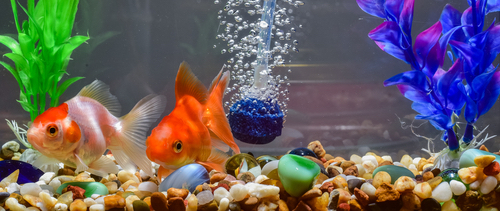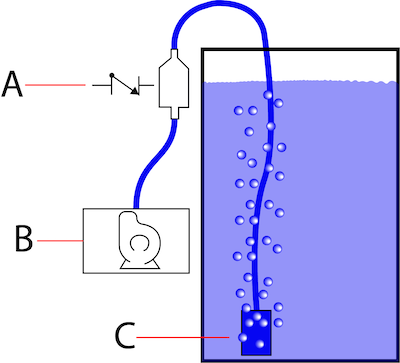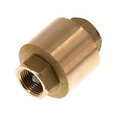Check Valves For Aquariums

Figure 1: Fish tank with air tube
Check valves for aquariums ensure unidirectional airflow from the air pump into the aquarium, effectively blocking any reverse flow of water through the tubing. This is particularly crucial during power outages or pump failures, as it prevents water from siphoning out of the aquarium. This article discusses the purpose, selection criteria, and installation requirements of aquarium check valves.
Table of contents
- Aquarium check valve purpose
- Selecting an aquarium check valve
- Aquarium check valve installation
- Is an aquarium check valve necessary?
- FAQs
View our online selection of check valves!
Aquarium check valve purpose
Air pumps feed air to various aquarium devices - such as filters, bubblers, air stones, and decorations - to keep oxygen levels in tanks high enough for fish to survive. An air pump positioned below the level of the air tube or airstone in an aquarium can cause the water in the tube to siphon back into the pump. If the pump fails or the airline becomes detached, the resulting water pressure can initiate a siphon effect, potentially leading to the complete drainage of the aquarium and posing a significant threat to aquatic life.
Check valves, also known as non-return valves, are small fittings installed inline on aquarium tubing to prevent backflow in the event of an air pump failure. They allow air or water to move in only one direction and thereby stop water from draining out of the tank, avoiding damage to the pump and reducing the risk of electrical issues. Check valves are necessary for any aquarium device that uses airline tubing, including sponge filters, aquarium ornaments, brine shrimp hatcheries, and CO2 injection systems.
Selecting an aquarium check valve
Material and size are two important factors when choosing a check valve for an aquarium.
-
Material: While most aquarium check valves are plastic, stainless steel and bronze check valves are also used.
- Metal: Metal check valves are unsuitable in saltwater aquariums because they corrode over time. Plastic check valves are lightweight, resistant to corrosion, and safe for use in both freshwater and saltwater aquariums.
- Kynar: Kynar check valves are specifically for when ozone is pumped into an aquarium. Ozone can melt other plastics.
- Size: The check valve must match the inner diameter of the air tubing. Standard tubing is 3/16 inch (5mm).
Aquarium check valve installation
In most cases, installing an aquarium check valve is a straightforward procedure. It is recommended to install the valve near the tank’s rim (Figure 2). Installing the check valve near the pump will allow water pressure to build further before encountering the check valve, which may lead to leaking.

Figure 2: Simple aquarium check valve (A) and air pump (B) setup. The device in the water (C) could be a sponge filter or air stone.
After determining where to install the check valve, use a sharp pair of scissors to cut the air tube at that spot and then attach each piece of air tubing to each end of the check valve. Ensure that the airline tubing is cut straight and cleanly, without tears. Over time, tubing may dry out and harden, which can lead to leaks. Regular inspection and replacement of tubing are recommended to maintain a secure connection.
The arrow on the valve points towards the direction of airflow. Ensure the valve is installed in the correct orientation. Read our check valve installation guide for more details on the check valve’s installation position and process.
The above installation instructions assume that the check valve is the only fitting installed on the tubing. The check valve installation location is slightly more complicated when other fittings are present. An aquarium check valve should be installed:
- After an opening in the tubing
- Before an airline control valve
- Before a gang valve (a device that splits the air supply into multiple lines, allowing control of airflow to different parts of the aquarium)
- After a bleed valve
- After or before an airline connector
Is an aquarium check valve necessary?
Adding a check valve to an aquarium air pump setup presents both advantages and disadvantages.
Advantage
- Provides additional protection in the event of air pump failure, preventing water from siphoning back into the pump.
Disadvantages
- May restrict airflow, which can be problematic if the air pump is precisely sized for the tank.
- Possibility of leakage over time, which can compromise the system's reliability.
Solutions
- To prevent leakage, ensure the check valve is properly fitted and use hose clamps for a secure connection.
- To address airflow restriction, select a pump that is slightly oversized for the tank and choose a check valve with low cracking pressure.
An alternative to using check valves is to position the air pump above the tank’s waterline. This arrangement ensures that, even if water siphons through the air tubing, it cannot rise above the tank's height, as gravity will naturally prevent backflow.
FAQs
What does an aquarium check valve do?
An aquarium check valve lets air flow from the air pump and into the tank but does not let air or water flow back towards the air pump.
Do you need a check valve for an aquarium?
A check valve is unnecessary for an aquarium if the air pump is placed above the aquarium’s waterline. In the case of water siphoning, the water won’t be able to flow much higher than the height of the tank.
Where should I put my aquarium check valve?
A check valve for an aquarium should be near the rim of the tank rather than near the air pump. This will stop the siphoned water near the source and help prevent valve leakage, which may happen if the valve is installed further down the line.






